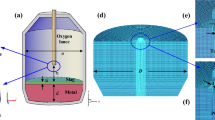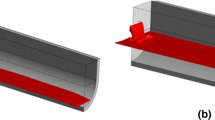Abstract
In the present work, the deoxidation of liquid steel with aluminum wire injection in a gas-stirred ladle was studied by mathematical modeling using a computational fluid dynamics (CFD) approach. This was complemented by an industrial trial study conducted at Uddeholm Tooling AB (Hagfors, Sweden). The results of the industrial trials were found to be in accordance with the results of the model calculation. In order to study the aspect of nucleation of alumina, emphasis was given to the initial period of deoxidation, when aluminum wire was injected into the bath. The concentration distributions of aluminum and oxygen were calculated both by considering and not considering the chemical reaction. Both calculations revealed that the driving force for the nucleation fo Al2O3 was very high in the region near the upper surface of the bath and close to the wire injection. The estimated nucleation rate in the vicinity of the aluminum wire injection point was much higher than the recommended value for spontaneously homogeneous nucleation, 103 nuclei/(cm3/s). The results of the model calculation also showed that the alumina nuclei generated at the vicinity of the wire injection point are transported to other regions by the flow.
Similar content being viewed by others
Abbreviations
- a i :
-
activity of element i
- A D :
-
projected area per unit volume (L/m)
- A 0 :
-
constant in equation for maximum nucleation rate
- C D :
-
drag coefficient
- C i :
-
concentration of element i, weight fraction
- d B :
-
diameter of gas bubble (m)
- D Al :
-
diffusion coefficient for aluminum (m2/s)
- D i,n :
-
inner diameter of gas inlet (m)
- D O :
-
diffusion coefficient for oxygen (m2/s)
- e j i :
-
interaction coefficient
- f i :
-
activity coefficient for element i
- F a :
-
friction force in the axial direction that the liquid exerts upon the gas at the interface per unit volume (N/m3)
- F r :
-
friction force in the radial direction that the liquid exerts upon the gas at the interface per unit volume (N/m3)
- ΔF v :
-
free energy per volume (J/m3)
- ΔF*:
-
activation energy (J/mole)
- ΔF m :
-
molar free energy (J/mole)
- g :
-
gravitational acceleration (m/s2)
- I :
-
maximum nucleation rate (1/cm3 s)
- k eq :
-
equillibrium constant
- k in :
-
turbulent kinetic energy at inlet (J/kg)
- P :
-
pressure (N/m2)
- q g :
-
gas flow rate (m3/s)
- r :
-
radial distance (m)
- R:
-
gas constant (J/mole K)
- Re:
-
Reynold’s dimensionless number
- S Ci :
-
source rate of C i (kg/m3 s)
- S ɛ :
-
source term in turbulence equation (kg/m s3)
- S g :
-
source term in turbulence equation (kg/m s4)
- t :
-
time (s)
- T :
-
temperature (K)
- u l :
-
velocity vector of liquid phase (m/s)
- v con :
-
reference value for v rel (m/s)
- v g :
-
radial velocity component of the gas (m/s)
- v l :
-
radial velocity component of the liquid (m/s)
- v p :
-
velocity vector where p stands for either liquid (l) or gas (g) phase (m/s)
- v rel :
-
relative velocity difference between gas and liquid in radial direction (m/s)
- V m :
-
molar volume (m3/mole)
- w con :
-
reference value for w rel (m/s)
- w g :
-
axial velocity component of the gas (m/s)
- w g,in :
-
axial velocity component for gas phase at gas inlet (m/s)
- w l :
-
axial velocity component of the liquid (m/s)
- w rel :
-
relative velocity difference between gas and liquid in axial direction (m/s)
- z :
-
axial distance (m)
- α l :
-
volume fraction of liquid
- α g :
-
volume fraction of gas
- ɛ in :
-
dissipation rate of turbulent kinetic energy at gas inlet (m2/s3)
- γ :
-
surface tension (N/m)
- γ l :
-
surface tension of liquid (N/m)
- μ eff :
-
effective viscosity (kg/m s)
- ρ g :
-
density of the gas (kg/m3)
- ρ l :
-
density of the liquid (kg/m3)
- τ rr,p :
-
component of the stress tensor where p stands for either liquid (l) or gas (g) phase
- τ rz,p :
-
component of the stress tensor where p stands for either liquid (l) or gas (g) phase
- τ zz,p :
-
component of the stress tensor where p stands for either liquid (l) or gas (g) phase
- \(\Gamma _{C_i } \) :
-
exchange coefficient of the entity c in the phase
References
S. Taniguchi and A. Kikichi: Tetsu-to-Hagané, 1992, vol. 78, pp. 527–35 (in Japanese).
S. Taniguchi, A. Kikichi, T. Ise, and N. Shoji: Iron Steel Inst. Jpn., 1996, vol. 36, pp. S117-S120.
H. Tozawa, Y. Kato, K. Sorimachi, and T. Nakanishi: Iron Steel Inst. Jpn., 1999, vol. 39, pp. 426–34.
D.B. Spalding: Mathematical Modelling of Fluid Mechanics, Heat-Transfer and Chemical Reaction Processes, A Lecture Course, Imperial College CFDU Report No. HTS/80/1, Imperial College, London, England.
P. Jönsson and L. Jonsson: Scand. J. Metall., 1995, vol. 24, pp. 194–206.
R. Clift, J.R. Grace, and M.E. Weber: Bubbles, Drops and Particles, Academic Press Inc., New York, NY, 1989.
K. Mori, M. Sano, and T. Sato: Iron Steel Inst. Jpn. Int., 1979, vol. 19, pp. 553–58.
B.E. Launder and D.B. Spalding: Mathematical Models of Turbulence, Academic Press, London, 1972.
I.S. Hamill and M.R. Malin: PHOENICS J., 1991, vol. 4, suppl. 2, p. 212.
B.E. Launder and D.B. Spalding: Comp. Meth. Appl. Mech. Eng., 1974, p. 269.
Y. Kawai and Y. Shiraishi: Handbook of Physico-Chemical Properties at High Temperatures, ISIJ, Tokyo, 1988.
J.F. Elliot, M. Gleiser, and V. Ramakrishna: Thermochemistry for Steelmaking, Addison-Wesley Publ. Co., Reading, MA, 1963, vol. 2.
T.C. Hsiao: MF 79063 E/2, MEFOS, Luleå, Sweden, 1979.
Hong Yong Sohn and Milton E. Wadsworth: Rate Processes of Extractive Metallurgy, Plenum Press, New York, NY, 1979, p. 399.
Author information
Authors and Affiliations
Rights and permissions
About this article
Cite this article
Beskow, K., Jonsson, L., Sichen, D. et al. Study of the deoxidation of steel with aluminum wire injection in a gas-stirred ladle. Metall Mater Trans B 32, 319–328 (2001). https://doi.org/10.1007/s11663-001-0055-1
Received:
Issue Date:
DOI: https://doi.org/10.1007/s11663-001-0055-1




